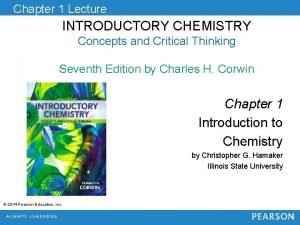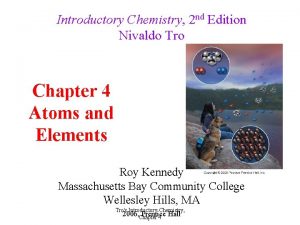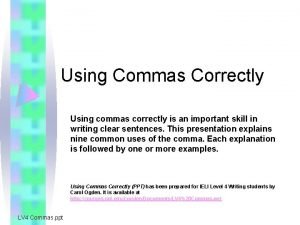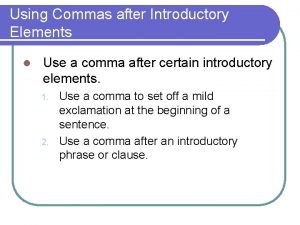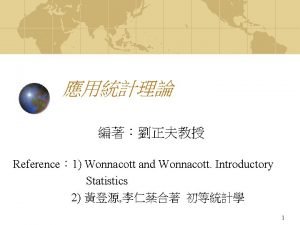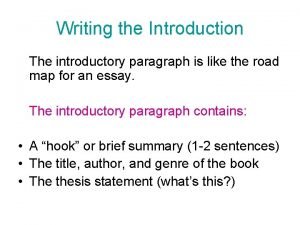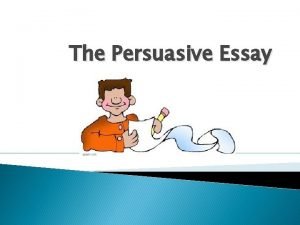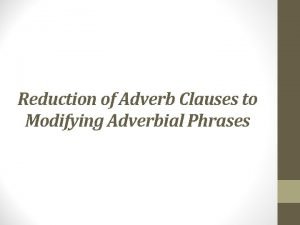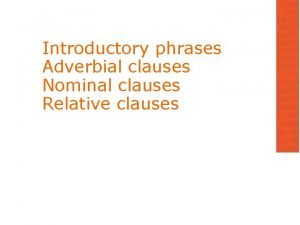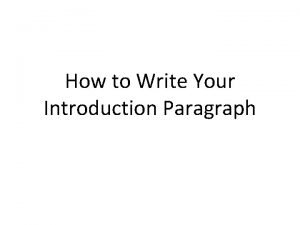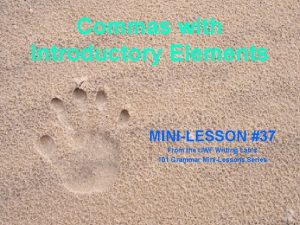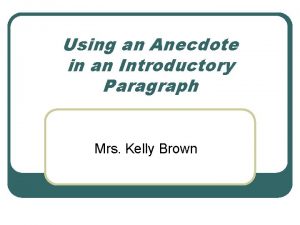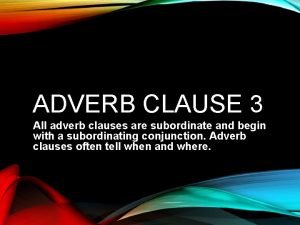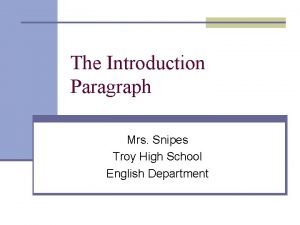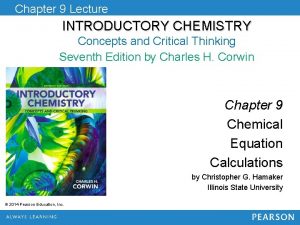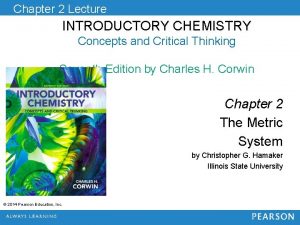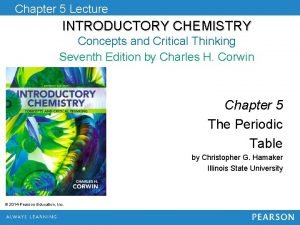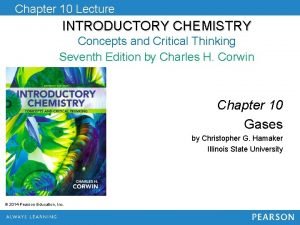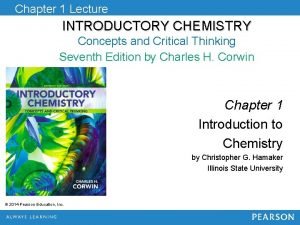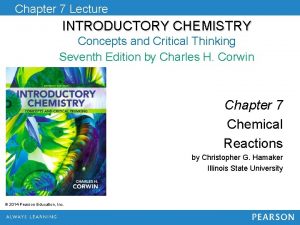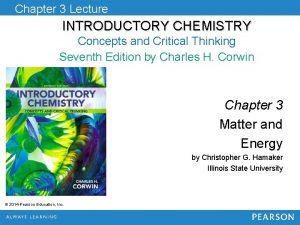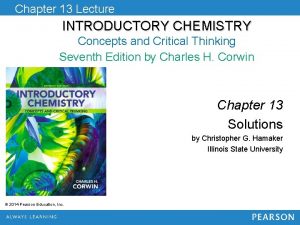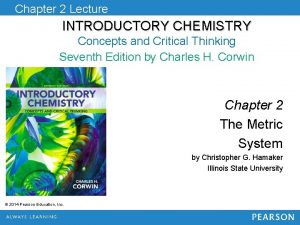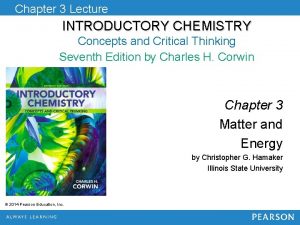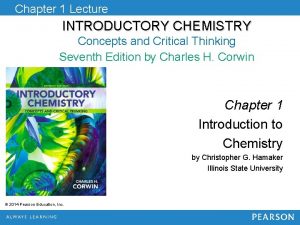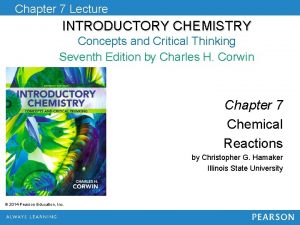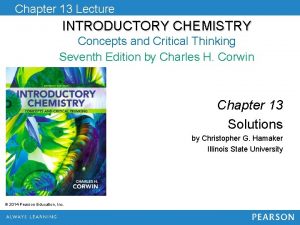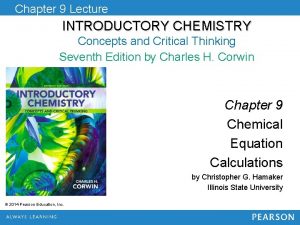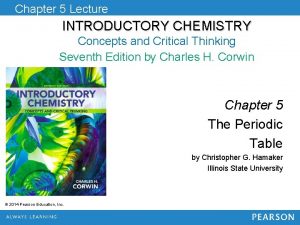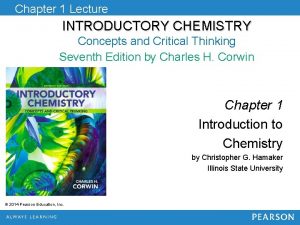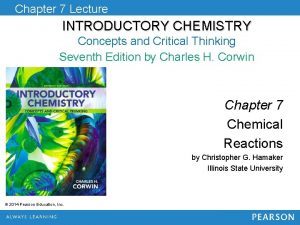Chapter 12 Lecture INTRODUCTORY CHEMISTRY Concepts and Critical
















































- Slides: 48

Chapter 12 Lecture INTRODUCTORY CHEMISTRY Concepts and Critical Thinking Seventh Edition by Charles H. Corwin Chapter 12 Chemical Bonding by Christopher G. Hamaker Illinois State University © 2014 Pearson Education, Inc.

Chemical Bond Concept • Recall that an atom has core and valence electrons. • Core electrons are found close to the nucleus. • Valence electrons are found in the most distant s and p energy subshells. • It is valence electrons that are responsible for holding two or more atoms together in a chemical bond. © 2014 Pearson Education, Inc. Chapter 12

Octet Rule • The octet rule states that atoms bond in such a way that each atom acquires eight electrons in its outer shell. • There are two ways in which an atom may achieve an octet: 1. Transfer of electrons from one atom to another 2. Sharing one or more pairs of electrons © 2014 Pearson Education, Inc. Chapter 12

Types of Bonds • Ionic bonds are formed when a metal cation is attracted to a nonmetal cation. • Covalent bonds are formed when two nonmetals share valence electrons. © 2014 Pearson Education, Inc. Chapter 12

Ionic Bonds • An ionic bond is formed by the attraction between a positively charged cation and a negatively charged anion. • This electrostatic attraction is similar to the attraction between opposite poles on two magnets. © 2014 Pearson Education, Inc. Chapter 12

Ionic Bonds, Continued • The ionic bonds formed from the combination of anions and cations are very strong and result in the formation of a rigid, crystalline structure. The structure for Na. Cl, ordinary table salt, is shown here. © 2014 Pearson Education, Inc. Chapter 12

Formation of Cations • Cations are formed when an atom loses valence electrons to become positively charged. • Most main group metals achieve a noble gas electron configuration by losing their valence electrons, and are isoelectronic with a noble gas. • Magnesium (Group IIA/2) loses its two valence electrons to become Mg 2+. • A magnesium ion has 10 electrons (12 – 2 = 10 e–) and is isoelectronic with neon. © 2014 Pearson Education, Inc. Chapter 12

Formation of Cations, Continued • We can use electron dot formulas to look at the formation of cations. • Each of the metals in Period 3 forms cations by losing one, two, or three electrons, respectively. Each metal atom becomes isoelectronic with the preceding noble gas, neon. © 2014 Pearson Education, Inc. Chapter 12

Formation of Anions • Anions are formed when a nonmetal atom gains electrons and becomes negatively charged. • Most nonmetals achieve a noble gas electron configuration by gaining electrons to become isoelectronic with a noble gas. • Chlorine (Group VIIA/17) gains one valence electron and becomes Cl–. • A chloride ion has 18 electrons (17 + 1 = 18 e–) and is isoelectronic with argon. © 2014 Pearson Education, Inc. Chapter 12

Formation of Anions, Continued • We can also use electron dot formulas to look at the formation of anions. • The nonmetals in Period 3 gain one, two, or three electrons, respectively, to form anions. Each nonmetal ion is isoelectronic with the following noble gas, argon. © 2014 Pearson Education, Inc. Chapter 12

Ionic Radii • The radius of a cation is smaller than the radius of its starting atom. • The radius of an anion is larger than the radius of its starting atom. © 2014 Pearson Education, Inc. Chapter 12

Covalent Bonds • Covalent bonds are formed when two nonmetal atoms share electrons, and the shared electrons in the covalent bond belong to both atoms. • When hydrogen chloride (HCl) is formed, the hydrogen atom shares its one valence electron with the chlorine. This gives the chlorine atom eight electrons in its valence shell, making it isoelectronic with argon. • The chlorine atom shares one of its valence electrons with the hydrogen, giving it two electrons in its valence shell, and making it isoelectronic with helium. © 2014 Pearson Education, Inc. Chapter 12

Bond Length • When a covalent bond is formed, the valence shells of the two atoms overlap with each other. • In HCl, the 1 s energy sublevel of the hydrogen atom overlaps with the 3 p energy sublevel of the chlorine atom. The mixing of sublevels draws the atoms closer together. • The distance between the two atoms is smaller than the sum of their atomic radii and is the bond length. © 2014 Pearson Education, Inc. Chapter 12

Bond Energy • Energy is released when two atoms form a covalent bond. H(g) + Cl(g) HCl(g) + heat • Conversely, energy is needed to break a covalent bond. • The energy required to break a covalent bond is referred to as the bond energy. The amount of energy required to break a covalent bond is the same as the amount of energy released when the bond is formed. HCl(g) + heat H(g) + Cl(g) © 2014 Pearson Education, Inc. Chapter 12

Electron Dot Formulas of Molecules • In Section 5. 8, we drew electron dot formulas for atoms. • The number of dots around each atom is equal to the number of valence electrons the atom has. • We will now draw electron dot formulas for molecules (also called Lewis structures). • A Lewis structure shows the bonds between atoms and helps us visualize the arrangement of atoms in a molecule. © 2014 Pearson Education, Inc. Chapter 12

Guidelines for Drawing Electron Dot Formulas of Molecules 1. Calculate the total number of valence electrons by adding all the valence electrons for each atom in the molecule. The total must be an even number to obey the octet rule. If the total is an odd number, check your calculations. 2. Divide the total valence electrons by 2 to find the number of electron pairs in the molecule. © 2014 Pearson Education, Inc. Chapter 12

Guidelines for Drawing Electron Dot Formulas of Molecules, Continued 3. Surround the central atom with four electron pairs. Use the remaining electron pairs to complete an octet around each of the other atoms. (Hydrogen is the sole exception as it requires only one electron pair. ) 4. If there are not enough electron pairs to provide an octet for each atom, move a nonbonding electron pair between two atoms that already share an electron pair. © 2014 Pearson Education, Inc. Chapter 12

Electron Dot Formula for Water, H 2 O 1. Count the total number of valence electrons: oxygen has six and each hydrogen has one for a total of eight electrons [6 + 2(1) = 8 e–]. The number of electron pairs is 4 (8/2 = 4). 2. Place eight electrons around the central oxygen atom. © 2014 Pearson Education, Inc. Chapter 12

Electron Dot Formula for Water, H 2 O, Continued 3. We can then place the two hydrogen atoms in any of the four electron pair positions. Notice there are two bonding and two nonbonding electron pairs. © 2014 Pearson Education, Inc. Chapter 12

Electron Dot Formula for Water, H 2 O, Continued 4. To simplify, we represent bonding electron pairs with a single dash line called a single bond. 5. The resulting structure is referred to as the structural formula of the molecule. © 2014 Pearson Education, Inc. Chapter 12

Electron Dot Formula for Sulfur Trioxide, SO 3 1. Count the total number of valence electrons: each oxygen has six and sulfur has six for a total of 24 electrons [3(6) + 6 = 24 e–]. This gives us 12 electron pairs. 2. Place four electron pairs around the central sulfur atom and attach the three oxygen atoms. We started with 12 electron pairs and have eight left. © 2014 Pearson Education, Inc. Chapter 12

Electron Dot Formula for Sulfur Trioxide, SO 3, Continued 3. Place the remaining electron pairs around the oxygen atoms to complete each octet. 4. One of the oxygen atoms does not have an octet, so move a nonbonding pair from the sulfur to provide two pairs between the sulfur and the oxygen. © 2014 Pearson Education, Inc. Chapter 12

Resonance • The two shared electron pairs constitute a double bond. • The double bond can be placed between the sulfur and any of the three oxygen atoms. The structural formula can be shown as any of the structures below. This phenomenon is called resonance. © 2014 Pearson Education, Inc. Chapter 12

Electron Dot Formula for NH 4+ 1. The total number of valence electrons is 5 – 4(1) – 1 = 8 e–. We must subtract one electron for the positive charge. We have four pairs of electrons. 2. Place four electron pairs around the central nitrogen atom and attach the four hydrogen atoms. 3. Enclose the polyatomic ion in brackets and indicate the charge outside the brackets. © 2014 Pearson Education, Inc. Chapter 12

Electron Dot Formula for CO 32– 1. The total number of valence electrons is 4 + 3(6) + 2 = 24 e–. We must add one electron for the negative charge. We have 12 pairs of electrons. 2. Place four electron pairs around the central carbon atom and attach the three oxygen atoms. Use the remaining electron pairs to give the oxygen atoms their octets. © 2014 Pearson Education, Inc. Chapter 12

Electron Dot Formula for CO 32–, Continued 3. One oxygen does not have an octet. Make a double bond and enclose the ion in brackets. © 2014 Pearson Education, Inc. Chapter 12

Polar Covalent Bonds • Covalent bonds result from the sharing of valence electrons. • Often, the two atoms do not share the electrons equally. That is, one of the atoms holds onto the electrons more tightly than the other. • When one of the atoms holds the shared electrons more tightly, the bond is polarized. • A polar covalent bond is one in which the electrons are not shared equally. © 2014 Pearson Education, Inc. Chapter 12

Electronegativity • Each element has an innate ability to attract valence electrons. • Electronegativity is the ability of an atom to attract electrons in a chemical bond. • Linus Pauling devised a method for measuring the electronegativity of each of the elements. • Fluorine is the most electronegative element. © 2014 Pearson Education, Inc. Chapter 12

Electronegativity, Continued • Electronegativity increases as you go left to right across a period. • Electronegativity increases as you go from bottom to top in a family. © 2014 Pearson Education, Inc. Chapter 12

Electronegativity Differences • The electronegativity of H is 2. 1; Cl is 3. 0. • Since there is a difference in electronegativity between the two elements (3. 0 – 2. 1 = 0. 9), the bond in H – Cl is polar. • Since Cl is more electronegative, the bonding electrons are attracted toward the Cl atom and away from the H atom. This will give the Cl atom a slightly negative charge and the H atom a slightly positive charge. © 2014 Pearson Education, Inc. Chapter 12

Delta Notation for Polar Bonds • We use the Greek letter delta, d, to indicate a polar bond. • The negatively charged atom is indicated by the symbol d–, and the positively charged atom is indicated by the symbol d+. This is referred to as delta notation for polar bonds. d+ © 2014 Pearson Education, Inc. H – Cl d– Chapter 12

Delta Notation for Polar Bonds, Continued • The hydrogen halides HF, HCl, HBr, and HI all have polar covalent bonds. • The halides are all more electronegative than hydrogen and are designated with a d–. © 2014 Pearson Education, Inc. Chapter 12

Chemistry Connection: Linus Pauling • Linus Pauling studied biochemistry, and won the 1954 Nobel Prize in Chemistry for his study of the structure of proteins. • He also studied chemical bonding and developed the electronegativity scale. • He was awarded the 1962 Nobel Peace Prize for his efforts to ban above-ground nuclear testing. © 2014 Pearson Education, Inc. Chapter 12

Nonpolar Covalent Bonds • What if the two atoms in a covalent bond have the same or similar electronegativities? • The bond is not polarized and it is a nonpolar covalent bond. If the electronegativity difference is less than 0. 5, it is usually considered a nonpolar bond. • The diatomic halogen molecules have nonpolar covalent bonds. © 2014 Pearson Education, Inc. Chapter 12

Coordinate Covalent Bonds • A covalent bond resulting from one atom donating an electron pair to another atom is called a coordinate covalent bond. • A good example of a molecule with a coordinate covalent bond is ozone, O 3. © 2014 Pearson Education, Inc. Chapter 12

Hydrogen Bonds • The bond between H and O in water is very polar. • Therefore, the oxygen is partially negative, and the hydrogen atoms are partially positive. • As a result, the hydrogen atom on one molecule is attracted to the oxygen atom on another. • This intermolecular attraction is referred to as a hydrogen bond. © 2014 Pearson Education, Inc. Chapter 12

Shapes of Molecules • Electron pairs surrounding an atom repel each other. This is referred to as Valence Shell Electron Pair Repulsion (VSEPR) theory. • The electron pair geometry indicates the arrangement of bonding and nonbonding electron pairs around the central atom. • The molecular shape indicates the arrangement of atoms around the central atom as a result of electron repulsion. © 2014 Pearson Education, Inc. Chapter 12

Tetrahedral Molecules • Methane, CH 4, has four pairs of bonding electrons around the central carbon atom. • The four bonding pairs (and, therefore, atoms) are repelled to the four corners of a tetrahedron. Thus, the electron pair geometry is tetrahedral. • The molecular shape is also tetrahedral. © 2014 Pearson Education, Inc. Chapter 12

Trigonal Pyramidal Molecules • In ammonia, NH 3, the central nitrogen atom is surrounded by three bonding pairs and one nonbonding pair. • Thus, the electron pair geometry is tetrahedral and the molecular shape is trigonal pyramidal. © 2014 Pearson Education, Inc. Chapter 12

Bent Molecules • In water, H 2 O, the central O atom is surrounded by two nonbonding pairs and two bonding pairs. • Thus, the electron pair geometry is tetrahedral and the molecular shape is bent. © 2014 Pearson Education, Inc. Chapter 12

Linear Molecules • In carbon dioxide, CO 2, the central C atom is bonded to each oxygen by two electron pairs (a double bond). • According to VSEPR theory, the electron pairs will repel each other and they will be at opposite sides of the C atom. • Thus, the electron pair geometry and the molecular shape are both linear. © 2014 Pearson Education, Inc. Chapter 12

Trigonal Planar Molecules • In formaldehyde, CH 2 O, the central C atom is bonded to the oxygen by two electron pairs (a double bond) and to each hydrogen atom by one electron pair. • The electron pair geometry and the molecular shape are both trigonal planar. © 2014 Pearson Education, Inc. Chapter 12

Summary of VSEPR Theory © 2014 Pearson Education, Inc. Chapter 12

Nonpolar Molecules with Polar Bonds • CCl 4 has polar bonds, but the overall molecule is nonpolar. • Using VSEPR theory, the four chlorine atoms are at the four corners of a tetrahedron. • The net effect of the polar bonds is zero, so the molecule is nonpolar. © 2014 Pearson Education, Inc. Chapter 12

Critical Thinking: Diamond versus Graphite • Why is diamond colorless and hard, while graphite is black and soft when both are pure carbon? • Diamond has a three-dimensional structure, whereas graphite has a two-dimensional structure. • The layers in graphite are able to slide past each other easily. © 2014 Pearson Education, Inc. Chapter 12

Chapter Summary • Chemical bonds hold atoms together in molecules. • Atoms bond in such a way as to have eight electrons in their valence shell. This is called the octet rule. • There are two types of bonds: ionic and covalent. • Ionic bonds are formed between a cation and an anion. • Covalent bonds are formed from the sharing of electrons. © 2014 Pearson Education, Inc. Chapter 12

Chapter Summary, Continued • Electron dot formulas help us visualize the arrangements of atoms in a molecule. • Electrons are shared unequally in polar covalent bonds. • Electronegativity is a measure of the ability of an atom to attract electrons in a chemical bond. • Electronegativity increases from left to right and from bottom to top on the periodic table. © 2014 Pearson Education, Inc. Chapter 12

Chapter Summary, Continued • VSEPR theory can be used to predict the shapes of molecules. • The electron pair geometry indicates the arrangement of bonding and nonbonding pairs around a central atom. • The molecular shape indicates the arrangement of atoms in a molecule. © 2014 Pearson Education, Inc. Chapter 12
 Introductory chemistry concepts and critical thinking
Introductory chemistry concepts and critical thinking Critical semi critical and non critical instruments
Critical semi critical and non critical instruments Principle of sterilization
Principle of sterilization Introductory chemistry 4th edition
Introductory chemistry 4th edition Prefix multipliers
Prefix multipliers Introductory chemistry 5th edition nivaldo j. tro
Introductory chemistry 5th edition nivaldo j. tro Nivaldo j. tro introductory chemistry
Nivaldo j. tro introductory chemistry 01:640:244 lecture notes - lecture 15: plat, idah, farad
01:640:244 lecture notes - lecture 15: plat, idah, farad Critical thinking concepts and tools
Critical thinking concepts and tools Advanced inorganic chemistry lecture notes
Advanced inorganic chemistry lecture notes An introduction to atmospheric physics
An introduction to atmospheric physics The miniature guide to critical thinking concepts & tools
The miniature guide to critical thinking concepts & tools Introductory statistics chapter 2 answers
Introductory statistics chapter 2 answers Compare non-critical readers with critical readers.
Compare non-critical readers with critical readers. 1-1 variables and expressions
1-1 variables and expressions Numerical expression
Numerical expression What is a pivot sentence in an essay
What is a pivot sentence in an essay Using therefore in middle of sentence
Using therefore in middle of sentence Commas after introductory phrases
Commas after introductory phrases Wonnacott and wonnacott introductory statistics pdf
Wonnacott and wonnacott introductory statistics pdf Introduction phrases
Introduction phrases Ib chemistry functional groups
Ib chemistry functional groups Inorganic vs organic chemistry
Inorganic vs organic chemistry Example of introductory paragraph with thesis statement
Example of introductory paragraph with thesis statement Lucy in the sky
Lucy in the sky Keeping your hands clean and dry persuasive essay
Keeping your hands clean and dry persuasive essay News story example
News story example Hooks paragraph
Hooks paragraph Paragraph on the desert
Paragraph on the desert Adverb clauses to modifying phrases
Adverb clauses to modifying phrases Atlas ti 7
Atlas ti 7 Introductory paragraph format
Introductory paragraph format Introductory adverbial clause examples
Introductory adverbial clause examples Introduction title examples
Introduction title examples Introductory maxqda course
Introductory maxqda course Introduction paragraph format
Introduction paragraph format Introductory phrases examples
Introductory phrases examples Army traffic safety training program
Army traffic safety training program Anecdote introduction example
Anecdote introduction example Introductory rite
Introductory rite Introductory paragraph hook strategies
Introductory paragraph hook strategies Examples of introduction paragraph
Examples of introduction paragraph Introductory adverb clause
Introductory adverb clause Comma introductory clause
Comma introductory clause Introduction paragraph examples high school
Introduction paragraph examples high school Activity 1 introductory activity
Activity 1 introductory activity Introductory performance review
Introductory performance review Middle school introduction paragraph examples
Middle school introduction paragraph examples Introductory elements examples
Introductory elements examples
